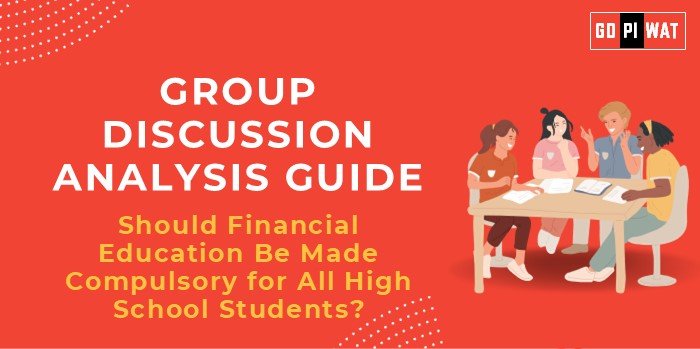📋 Group Discussion (GD) Analysis Guide: Should Financial Education Be Made Compulsory for All High School Students?
🌐 Introduction
As financial systems grow more sophisticated, financial literacy becomes essential for managing personal and societal wealth. Despite India ranking 23rd out of 28 countries in financial literacy (2012), the integration of financial education in high school curricula remains under-discussed, highlighting a critical gap in equipping youth with essential life skills.
📊 Quick Facts & Key Statistics
• 🌍 Global Financial Literacy Rank: India ranked 23rd out of 28 countries in financial literacy in 2012, indicating a large gap.
• 🧑🎓 Youth Job Disruptions: 2 in 5 individuals aged 18–24 faced job disruptions during the pandemic, emphasizing the importance of financial planning skills.
• 📈 Education Impact: Financial education boosts youth participation in financial markets, aiding goal achievement and credit discipline.
• 🇮🇳 Indian Context: Approximately 76% of Indian adults lack financial literacy, underscoring the need for early financial education.
• 🧑🎓 Youth Job Disruptions: 2 in 5 individuals aged 18–24 faced job disruptions during the pandemic, emphasizing the importance of financial planning skills.
• 📈 Education Impact: Financial education boosts youth participation in financial markets, aiding goal achievement and credit discipline.
• 🇮🇳 Indian Context: Approximately 76% of Indian adults lack financial literacy, underscoring the need for early financial education.
👥 Stakeholders and Their Roles
- Government: Develop policies and allocate budgets to integrate financial education into school systems.
- Educational Institutions: Design effective curricula and train teachers to deliver financial literacy programs.
- NGOs and Fintech Firms: Provide resources and digital tools to make financial education engaging and accessible.
- Parents and Guardians: Reinforce financial lessons at home through real-life applications.
🏆 Achievements and Challenges
- Achievements:
- ✅ Encourages youth participation in financial markets, building lifelong financial discipline.
- ✨ Enables students to handle financial uncertainties, such as those experienced during the pandemic.
- Challenges:
- ⚠️ High percentage of financially illiterate adults in India (76%) indicates systemic gaps in foundational education.
- 👩🏫 Inadequate teacher training and curriculum integration remain key barriers.
- 🌍 Lack of equitable access to resources, particularly in rural schools, may exacerbate disparities.
🗣️ Effective Discussion Approaches
- Opening Approaches:
- 💬 Reference India’s low financial literacy ranking (23rd globally in 2012) to highlight the problem.
- 💬 Start with real-life examples of financial mismanagement among youth, especially during crises like the pandemic.
- Counter-Argument Handling: Acknowledge concerns about implementation costs and counter with evidence of long-term societal and economic benefits.
🔍 Strategic Analysis of Strengths & Weaknesses
- 🏅 Strengths:
- ✅ Empowers students with practical financial skills.
- 📈 Reduces long-term reliance on debt and promotes credit discipline.
- ⚠️ Weaknesses:
- 👩🏫 Insufficient teacher expertise in financial topics.
- 📚 Overloaded school curricula make integration challenging.
- 🌱 Opportunities:
- 🤝 Partnerships with fintech firms for cost-effective delivery.
- 🎮 Use of gamified apps to make learning engaging.
- ⚡ Threats:
- ⚠️ Resistance from policymakers hesitant to overhaul the curriculum.
- 🏘️ Persistent rural-urban educational disparities.
📋 Structured Arguments for Discussion
- Supporting Stance: “Financial education equips students to navigate increasingly complex economic systems and secure their financial futures.”
- Opposing Stance: “Mandatory financial education could strain already resource-limited schools and distract from core subjects.”
- Balanced Perspective: “Financial education is crucial but requires phased implementation to address training and resource gaps.”
🎓 Connecting with B-School Applications
- Real-World Applications: Use insights to analyze financial inclusion models, assess fintech innovations, or design school-based financial literacy programs.
- Sample Questions:
- 💡 “What role does financial literacy play in economic resilience during crises?”
- 💡 “How can fintech enhance financial education delivery in schools?”
- Insights for Students: Apply concepts in internship projects, such as evaluating financial literacy programs’ impact on economic inclusivity.


